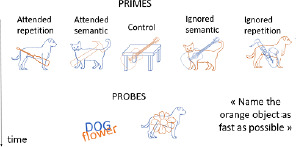Table 1.
Description of verbal and visual RI tasks cited in this review.
|
| ||||||
|---|---|---|---|---|---|---|
| TASK | SOURCE | TYPE OF RI | STIMULI (EXAMPLES) | DESCRIPTION | MAIN EFFECTS | DOMAINS |
|
| ||||||
| Stroop | Stroop (1935), Parris et al. (2022) | Interference caused by conflict between font color and word reading |

|
Naming of the color font as quickly as possible | Increased naming latencies in the incongruent condition (CARD C) compared to the congruent condition | Verbal |
|
| ||||||
| Verbal Go/No-Go | Interference between target and non-target stimulus status |

|
Pressing a key as quickly as possible for a specific word/letter/semantic category (Go condition) and ignore all other stimuli (No-Go condition)) | More commission errors and slower response times for No-Go trials | Verbal | |
|
| ||||||
| Negative-priming task | Tipper (1985), (2001); Tipper & Cranston (1985); Tipper & Driver (1988) | Interference caused by the change of stimulus status: a distractor stimulus becomes a target stimulus |

|
Naming objects in orange font as quickly as possible | Increased reaction times and error rates for a target that had to be ignored in a previous trial | Semantic |
|
| ||||||
| Semantic blocked cyclic naming | Schnur et al. (2006); Schnur et al. (2009) | Build-up of semantic interference |

|
Naming the pictures as quickly as possible | Slower response times and increased error rates when the repeatedly presented objects are from the same semantic category | Semantic |
|
| ||||||
| Phonological blocked cyclic naming | Damian, 2003; Hodgson et al., 2005 | Build-up of phonological interference |

|
Naming the pictures as quickly as possible | Slower response times and increased error rates when the repeatedly presented objects are phonologically similarly | Phonological |
|
| ||||||
| Picture-Word Interference | Glaser & Düngelhoff (1984) | Build-up of phonological and/or semantic interference |

|
Naming the pictures as quickly and accurately as possible while ignoring the superimposed words | Slower response times and increased error rates for related distractor | Verbal |
|
| ||||||
| Similarity-Judgement Task | Attout et al. (2022), Snyder et al. (2007) | Build-up of phonological and/or semantic interference |

|
Choosing which word at the bottom of the screen is most similar to the two words at the top of the screen, as quickly and accurately as possible. | Slower response times and increased error rates in the high control conditions as the prime word induced interference. | Verbal |
|
| ||||||
| Dual-Interference Task | Pashler (1994) | Build-up of verbal or visual interference |

|
Concurrently and alternatively process two types of information. The tested condition (here, verbal) can be cued or uncued. | Increased error rates and longer reaction time in the tested condition (here, verbal) | Verbal and/or Visual |
|
| ||||||
| Flanker task | Eriksen & Eriksen (1974) | Response interference |

|
Pressing of a response button according to a predefined response setup. This target can be flanked by a stimulus requiring the same or a different response as the target. | Increased reaction times if target is flanked by an item requiring a different response (interference) and reduced reaction times if target is flanked by an item requiring the same response (facilitation) | Verbal |
|
| ||||||
| Visual | ||||||
|
| ||||||

|
||||||
|
| ||||||
| Visual Go/No-Go | Resist to a visual stimulus |

|
Participants have to press a key as quickly for target symbols (e.g.,Ï), (Go condition), and ignore all other stimuli (No-Go condition). | More commission errors and slower response times for No-Go trials | Visual | |
|
| ||||||
| Antisaccade | Adapted from Noorani (2014) | Resist to visual stimulus |

|
Participants have to fixate a central stimulus and keep fixating the stimulus (green dot). Next a target (the cross) appears to the left, or the right of the dot and participants have to make an eye saccade to the opposite side (=antisaccade). | More errors/slower eye movements for antisaccade trials | Visual |
|
| ||||||
